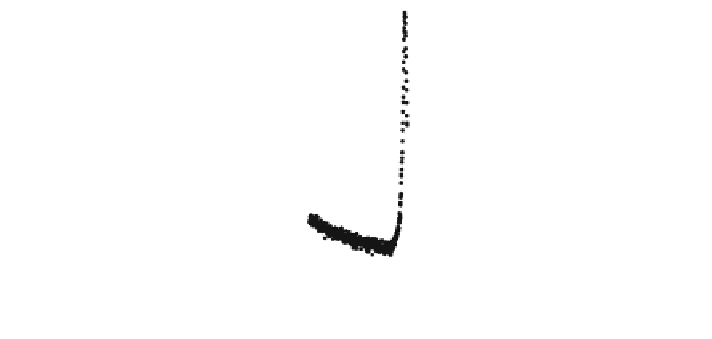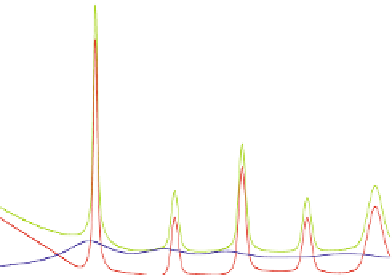Chemistry Reference
In-Depth Information
4.8 Milled Fe Nanostructured Powders
Nanostructured Fe powders were also elaborated from microcrystalline Fe pow-
ders by means of high energy ball milling using planetary ball under Ar atmo-
sphere [
159
]. Their reproducibility is well achieved providing similar milling
conditions: ball to powder weight ratio, milling speed, milling time, milling
atmosphere, nature of balls and mill vial while some of them have to be considered
to prevent from contamination and oxidation of metallic powders.
High statistics X-ray patterns recorded on milled Fe powders for different times
allow to model the nanocrystalline structure including the size and morphology of
coherent diffraction domain and their relative proportion, providing an additive
component is introduced to describe the low part of Bragg peaks. The experi-
mental pattern is compared in Fig.
4.8
to the theoretical one obtained by means of
Maud procedure which is based on the Rietveld method combined with Fourier
analysis. In addition, the mean morphology of the coherent diffraction domain
illustrated in inset of Fig.
4.18
suggests that the nanocrystalline grains behave
10-12 nm pseudo-cubes, favouring a dense packing through thin grain boundaries
[
159
]. In this hypothesis, the thickness of the grain boundary can be roughly
estimated at about 0.8 nm, i.e. 2-3 atomic layers, smaller than those observed
previously in the case of Fe clusters generated by inert gas condensation and in situ
consolidated [
158
].
On the contrary, Mössbauer spectrometry does not provide any further infor-
mation except that the presence of sextet typical of bcc-Fe structure remains
milling time independent, as observed in Fig.
4.19
. Low temperature Mössbauer
spectra confirm such a tendency as the hyperfine structure resulting from a single
magnetic sextet is not affected. At this stage, one does consider that the grain
boundaries which do not contribute to the hyperfine structure are only weakly
disordered and quite narrow. High temperature spectra could eventually cause a
splitting of the hyperfine structure but they were not recorded because of any
Fig. 4.18 32 h Fe milled
powder X-ray pattern fitted
with two components and
morphology of crystalline
grains [
159
]
50
grain
GB
40
30
20
10
0
20
40
60
80
100
120
2*Theta




























